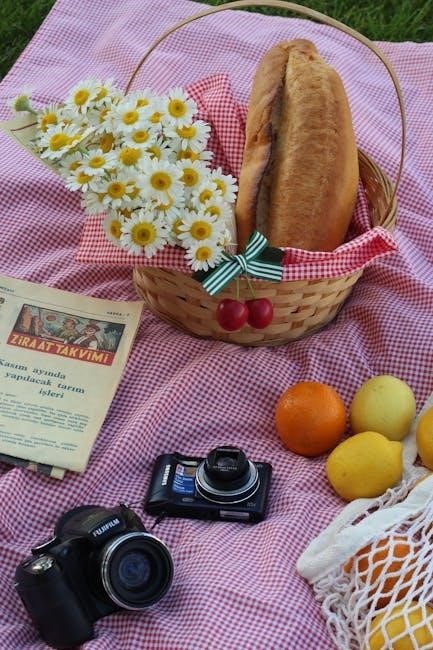A comprehensive guide to essential knots, the Book of Knots PDF is a must-have for enthusiasts and professionals. It covers everything from basic to advanced techniques.
Overview of the Book
The Book of Knots PDF is a detailed guide covering various aspects of knots, from basic techniques to advanced methods. It serves as a valuable resource for both enthusiasts and professionals, offering insights into the history, cultural significance, and practical applications of knots. The book is organized into clear sections, making it easy to navigate and learn. It emphasizes the importance of knots in fields like sailing, camping, and even art. With its comprehensive approach, the book becomes an essential tool for anyone looking to master the art of knot-tying.
Importance of Knots in Various Fields
Knots play a crucial role in numerous fields, including sailing, climbing, camping, and even art. In sailing, they ensure secure rigging and docking, while in climbing, they are essential for safety and support. Camping relies on knots for shelter and gear setup. Beyond practical uses, knots hold cultural and artistic significance, symbolizing unity and creativity. Their versatility and historical depth make them indispensable across diverse industries and hobbies, highlighting their enduring relevance in both functional and decorative contexts. This importance is thoroughly explored in the Book of Knots PDF.
History and Origins of Knots
Knots trace their origins to ancient civilizations, with early uses in navigation, daily life, and cultural rituals. The Book of Knots PDF explores their rich, evolving history.
Early Uses of Knots in Navigation and Daily Life
Knots have been integral to human progress, with early uses in navigation, fishing, and securing goods. Ancient mariners relied on knots for sailing, while they also served in crafting tools and shelter. Their versatility extended to daily life, symbolizing unity and strength in various cultures. From the bowline to the sheet bend, these knots laid the foundation for modern applications, showcasing their enduring importance across centuries.
Cultural Significance of Knots Across Civilizations
Knots hold deep symbolic meanings in various cultures, representing unity, eternity, and spiritual bonds. In Celtic traditions, intricate knotwork signifies eternal life. Chinese culture uses knots in decorations to symbolize good fortune and longevity. Similarly, Native American tribes employed knots in rituals and storytelling. These symbols transcend practical uses, becoming meaningful elements in art, religion, and identity, reflecting the universal human connection to knot-tying as an art form and a carrier of cultural heritage.

Popular Types of Knots and Their Uses
Common knots include stopper knots, bends, loops, hitches, and lashing knots, each serving specific purposes in sailing, camping, and securing loads effectively.
Stopper Knots
Stopper knots are essential for preventing ropes from running out of pulleys or blocks. They are typically bulky and secure, often used in sailing and climbing. The Overhand Knot is the simplest, while the Figure Eight Knot is more reliable and easier to untie. These knots are crucial for safety, ensuring lines remain fixed under tension. Their versatility makes them indispensable in various applications, from securing loads to creating fixed points in rope systems. Stopper knots are a fundamental skill for anyone working with ropes, offering reliability and peace of mind in critical situations.
Bends and Loops
Bends and loops are fundamental knot categories, serving distinct purposes. Bends join two ropes, like the Sheet Bend and Blood Knot, while loops create fixed points, such as the Bowline and Palomar Knot. These knots are versatile, used in sailing, camping, and rescue operations. Loops provide secure anchor points, while bends ensure strong rope connections. Mastering these knots enhances rope-handling efficiency, making them indispensable for both practical and recreational applications. Their reliability and adaptability make them cornerstone techniques in knot-tying skills.
Hitches and Lashing Knots
Hitches and lashing knots are essential for securing objects or extending loads. Hitches like the Clove Hitch and Round Turn are widely used in docking and temporary fastening. Lashing knots, such as the Square Lashing, are perfect for joining poles or logs. These knots provide secure holds and distribute weight evenly, making them indispensable in sailing, camping, and construction. Their adaptability ensures reliability in various scenarios, offering practical solutions for everyday challenges. Mastering hitches and lashings enhances one’s ability to handle ropes efficiently and safely in diverse applications.
Notable Authors and Their Contributions
Notable authors have significantly contributed to knot knowledge. Clifford Ashley’s seminal work laid the foundation, while others like Geoffrey Budworth expanded practical applications in various fields.
Clifford Ashley and The Ashley Book of Knots
Clifford W. Ashley’s “The Ashley Book of Knots” is a seminal work in knot-tying literature. First published in 1944, it contains over 7,000 knots, meticulously documented with detailed illustrations. Ashley’s passion for knots led him to spend years researching and compiling this comprehensive guide, which covers everything from nautical knots to decorative ones. His work remains a cornerstone for both enthusiasts and professionals, offering insights into the historical and practical uses of knots across various industries. The book’s depth and clarity have made it an indispensable resource for generations.

Other Influential Books on Knots
Beyond Clifford Ashley’s work, other notable books on knots include “The Everything Knots Book” and “The Useful Knots Book.” These guides provide practical, step-by-step instructions for tying various knots, catering to both beginners and experts. “The Everything Knots Book” covers over 100 knots, while “The Useful Knots Book” focuses on essential knots for survival and outdoor activities. These resources offer clear diagrams and tips, making them invaluable for anyone seeking to master knot-tying skills across different fields.

How to Use the Book of Knots PDF
The Book of Knots PDF provides easy-to-follow instructions for mastering various knots. Users can quickly search for specific knots, making it a practical tool for learning.
Learning to Tie Knots
Mastering knots begins with understanding the basics. The Book of Knots PDF offers step-by-step guides, clear illustrations, and practical tips for tying knots efficiently. Whether for camping, sailing, or everyday use, the guide ensures that learners can progress from simple to complex knots with ease. The PDF format allows users to search for specific knots quickly, making it an invaluable resource for both beginners and experienced enthusiasts. Regular practice and patience are key to becoming proficient in knot-tying techniques.

Understanding Rope and Twine
Choosing the right rope or twine is crucial for effective knot-tying. The Book of Knots PDF explains the differences between natural and synthetic fibers, highlighting their durability and flexibility. It also covers how rope thickness and texture impact knot performance. Whether for camping, sailing, or crafting, understanding the material ensures better results. The guide provides tips on selecting the appropriate rope for specific tasks, helping users achieve secure and reliable knots every time. Proper care and maintenance of ropes are also discussed to extend their lifespan.
Troubleshooting Common Mistakes
The Book of Knots PDF addresses frequent errors learners make while tying knots. Common issues include incorrect wrapping, insufficient tension, or improper loop formation. The guide offers clear solutions, such as checking rope alignment and ensuring even pressure. It emphasizes the importance of patience and practice to master techniques. Visual aids and step-by-step instructions help identify and correct mistakes, making the learning process smoother. By understanding these pitfalls, users can refine their skills and achieve consistent results in knot-tying. This section is invaluable for both beginners and experienced practitioners seeking to improve their craft.
Advanced Knot-Tying Techniques
The Book of Knots PDF explores advanced methods, including decorative knotting and specialized knots for sailing and climbing. These techniques offer detailed insights for experienced practitioners.
Decorative Knotting
Decorative knotting transforms practical knots into artistic expressions. The Book of Knots PDF highlights techniques like the Monkey’s Fist and Turk’s Head, often used in art and jewelry. These knots, with their intricate patterns and symmetry, add elegance to home décor and sailing rigs. Clifford Ashley’s work inspires creativity, showing how knots can transcend functionality. From wall hangings to ceremonial ropes, decorative knotting blends tradition with modern design, making it a cherished skill for crafters and enthusiasts alike. This art form showcases the timeless beauty of knots in unique and imaginative ways.
Specialized Knots for Sailing and Climbing
Specialized knots are crucial for sailing and climbing, ensuring safety and efficiency. The Book of Knots PDF details sailing knots like the Bowline, essential for securing ropes, and the Reef Knot, used for sail adjustments. For climbing, the Figure Eight and Prusik knots are highlighted, providing secure anchor points and rope ascension. These knots are tailored for extreme conditions, offering reliability and precision. The book’s insights make it a vital resource for both sailors and climbers, enhancing their skills and confidence in challenging environments.


Practical Applications of Knots
Knots are essential in sailing, camping, and survival, providing practical solutions for securing loads, climbing, and creating shelter. Their versatility ensures safety and efficiency in everyday and specialized tasks.
Knots in Sailing and Boating
Knots are indispensable in sailing and boating, ensuring safety and efficiency at sea. From securing anchors to adjusting sails, specific knots like the bowline and sheet bend are crucial. The book of knots PDF details these essential techniques, providing clear instructions for tying reliable knots. Whether anchoring, mooring, or hoisting sails, mastering these knots is vital for any sailor. The guide caters to both beginners and experienced mariners, offering practical solutions for various nautical challenges. Its comprehensive coverage makes it an invaluable resource for ensuring secure and efficient sailing operations.
Knots in Camping and Survival
Knots are vital for camping and survival, enabling secure shelter setup, gear hoisting, and rope repairs. The bowline knot creates reliable loops, while the trucker’s hitch secures heavy loads. The clove hitch adjusts tension on tent lines, and the taut-line hitch tightens tarps. These knots are essential for constructing shelters, lifting gear, and creating makeshift solutions in the wilderness. The book of knots PDF provides step-by-step guides for these techniques, ensuring campers and survivalists can master them efficiently. This knowledge is crucial for staying safe and resourceful in outdoor adventures.
Knots in Art and Craft
Knots transcend functionality, becoming a medium for artistic expression. Decorative knots like the Turk’s head and Matthew Walker are prized for their symmetry and beauty. The Book of Knots PDF highlights how these knots inspire jewelry, home decor, and traditional crafts. Artists use intricate knotting techniques to create visually striking designs, blending culture and creativity. The guide provides step-by-step instructions, enabling crafters to incorporate knots into unique pieces; This fusion of art and practicality showcases knots as both functional and aesthetically pleasing, making them a versatile tool for creative expression.
Glossary of Knot-Tying Terms
The glossary provides clear definitions of essential knot-tying terms, ensuring clarity for beginners and experts alike. Terms like standing part (the static portion of a rope) and working end (the active part used to tie knots) are explained. It also covers loop (a folded rope), bend (joining two ropes), hitch (securing a rope to an object), and lashing (binding objects together). This section serves as a quick reference guide, enhancing understanding and mastery of knot-tying techniques.

Why Knots Matter in the Modern World
Knots remain crucial in various modern applications, ensuring safety and efficiency across industries. In construction, reliable knots prevent accidents, while in medicine, precise surgical knots are vital for patient care. Outdoor enthusiasts depend on durable knots for climbing and camping. The maritime industry still relies on traditional knotting for secure navigation. Beyond functionality, knots inspire artistic creativity in crafts like macrame. The Book of Knots PDF offers essential techniques for these diverse needs, serving as a versatile resource in today’s world.

How to Download and Use the Book of Knots PDF
Download the PDF, ensure OCR for searchability, and easily navigate through its detailed guide. Perfect for enthusiasts and professionals seeking quick access to knot-tying techniques.
Benefits of a Digital Knot Guide
A digital knot guide offers unparalleled convenience, portability, and accessibility. With features like search functionality and high-quality visuals, it enables quick access to specific knots. The PDF format ensures compatibility across devices, making it ideal for on-the-go use. Users can easily navigate and reference techniques without the bulk of a physical book. Additionally, digital guides often include hyperlinks and indexes, enhancing the learning experience. This modern approach to knot-tying makes it easier for both novices and experts to master various techniques efficiently.
Searching for Specific Knots
The ability to search for specific knots in a digital guide is a significant advantage. A PDF with OCR (Optical Character Recognition) allows users to quickly locate knots by name or keyword, saving time and effort. This feature is particularly useful for enthusiasts and professionals who need immediate access to information. The guide’s comprehensive index and clear organization ensure that users can efficiently find the desired knots. This functionality makes the Book of Knots PDF an indispensable resource for anyone seeking detailed knot-tying techniques and applications.

Limitations of the Book of Knots PDF
While the Book of Knots PDF is a valuable resource, it has some limitations. The digital format lacks interactive elements, such as videos or step-by-step animations, which could enhance learning. Additionally, the PDF’s reliance on OCR for search functionality can sometimes lead to inaccuracies if the document isn’t properly formatted. Some users may also find the text-heavy layout less engaging compared to visually oriented guides. Despite these drawbacks, the book remains a comprehensive guide for knot enthusiasts and professionals alike.
